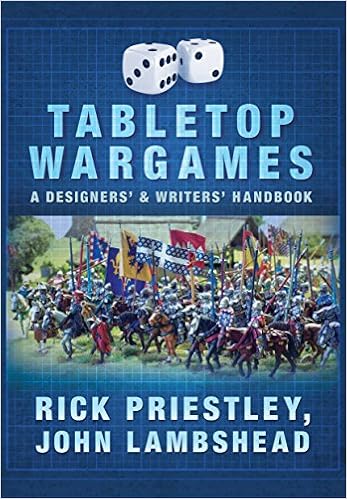I read the 3 original Warhammer booklets front to back, back to front, studying every little detail and drawing. This was also my first discovery of roleplaying games, so it really was a treasure chest of ideas opening up to me. I still didn't have any miniatures, so we used plastic 1/72 Romans (from this kit - still in my possession) to serve as Orcs and Dwarves. Later on I upgraded to Warhammer 3rd edition (skipped 2nd), and again, a Walhalla of gaming ideas was presented in that book. I slavishly followed White Dwarf, and the GW design team were like demigods to me - unreachable, in a country far away (sort of :-)), and full of wargaming wisdom (or so I thought :-)).
Although I stopped playing Warhammer when 4th edition came out, whenever I see the name of Rick Priestley (one of the original Warhammer authors) on a new publication, my mind always rushes back to those early days. So it was with some anticipation that I started reading the book "Tabletop Wargames - A designers' and writers' handbook" (published by Pen and Sword), written by that very same Rick Priestley, together with John Lambshead.
"Tabletop Wargames - A designers' and writers' handbook" is firmly taking the point-of-view of the game as a game, rather than as a simulation of military (fictional) history, which I find to be a refreshing and more down-to-earth approach, closely resembling my own design philosophy w.r.t. miniature wargames.
This is nicely illustrated in Chapter 2, in the section on "Fire and Movement Scales". The authors start the classic exercise of turning ground scale into movement rates given the time scale for a turn, but then come to the conclusion this gives weird results combined with scaled-down firing ranges - either producing ranges which are ridiculously long or short. In the end, movement and firing are decided on ranges which "work" on the gaming the table. To quote from the book: "[...] works so well because the game feels right, not because it conforms to some mathematical formula."
Chapter 3 gives a nice explanation on "tight games design" - having rules which cause minimal interference with each other. A good example is given by the movement rules. These can be designed such that they work well during the movement phase, but do you also want to use them (and hence, do they also work properly?) during other phases of the turn when troops move, e.g. during routs or combat results? Keeping a tight design means 'no', but that then infringes on the realistic feel of the game. Thus, some level of cross-domain rules will probably always be necessary.
When writing my own rules, I have always been trying to get very tight and clean designs. But after reading this book, I might change my thinking a bit. One specific section that opened my eyes was the section on "grit" - inserting tension and interest in the game by introducing a gaming mechanic that is alien to the core system. As an example, the book gives the blunder table in Black Powder, which is an additional roll to a failed command roll, but does provide tension and drama to the game. Another example might be a specific procedure to resolve cannon fire using a burst template or some other device.
I will not summarize all other chapters in length, but to be complete:
- Chapter 4 deals with dice mechanics - nothing really new there.
- Chapter 5 describes the presentation of rules, something that is mostly of importance when you want to publish your rules for a wider audience. Some good tips and tricks here! Chapter 7 follows up on that by how language should be used to describe the various sections of the rules.
- Chapter 6 and 9 handle skirmish games and campaign games respectively, and how these require some special attention.
- Chapter 8 was also rather interesting, with a section on points and point values, taking a very common sense approach towards the "point values in wargaming" debate.



Nice review. Thanks.
ReplyDelete